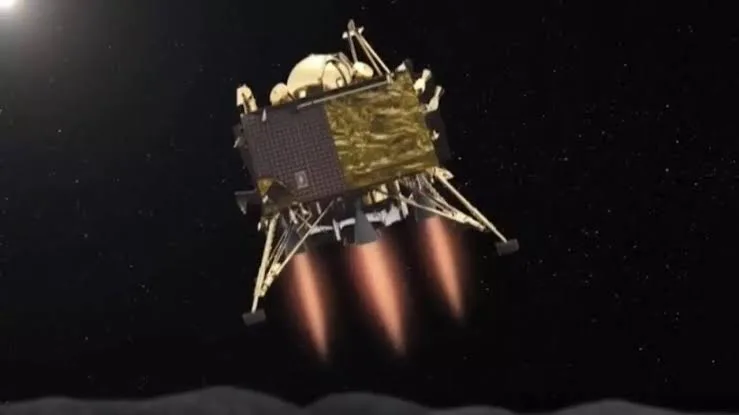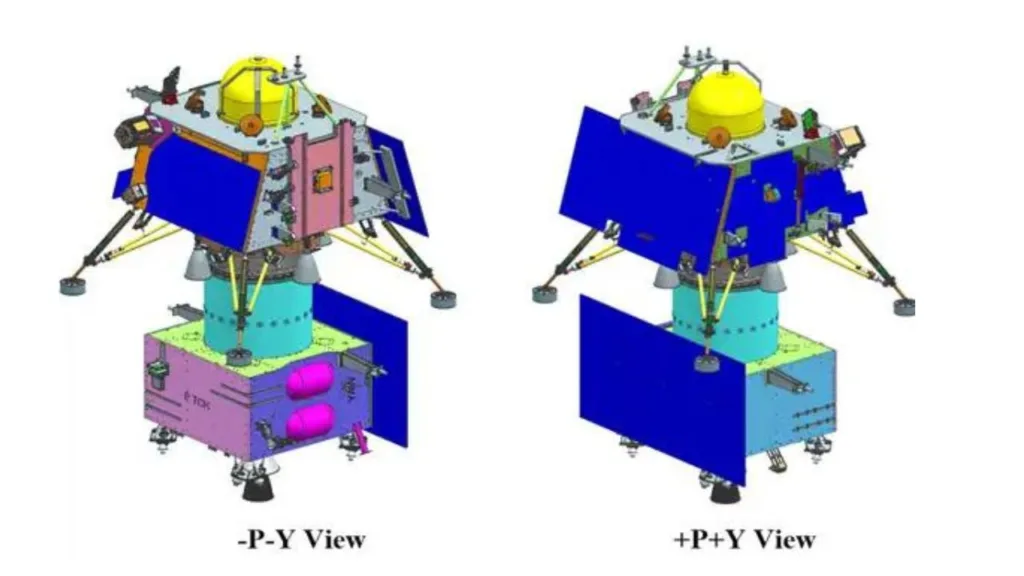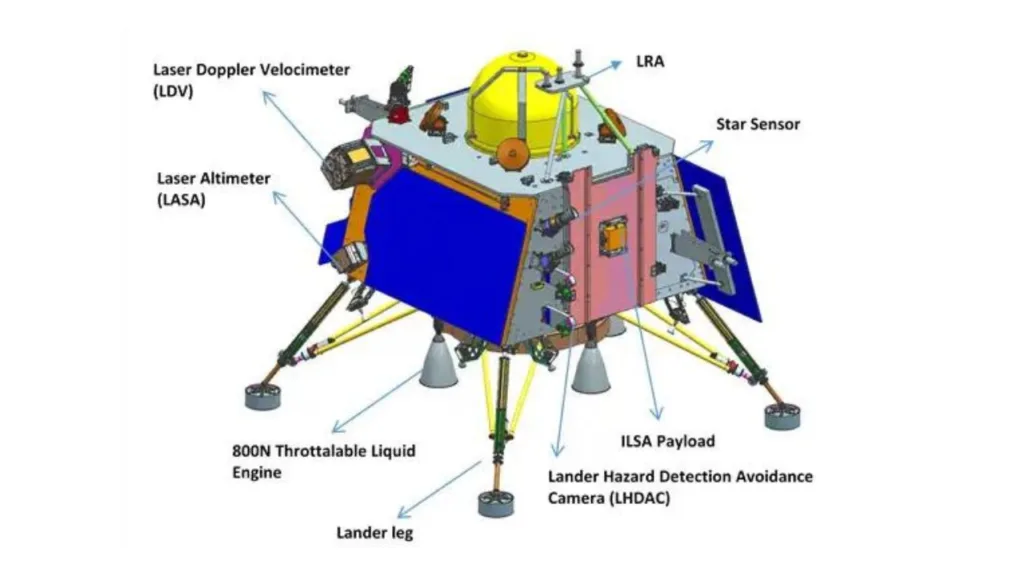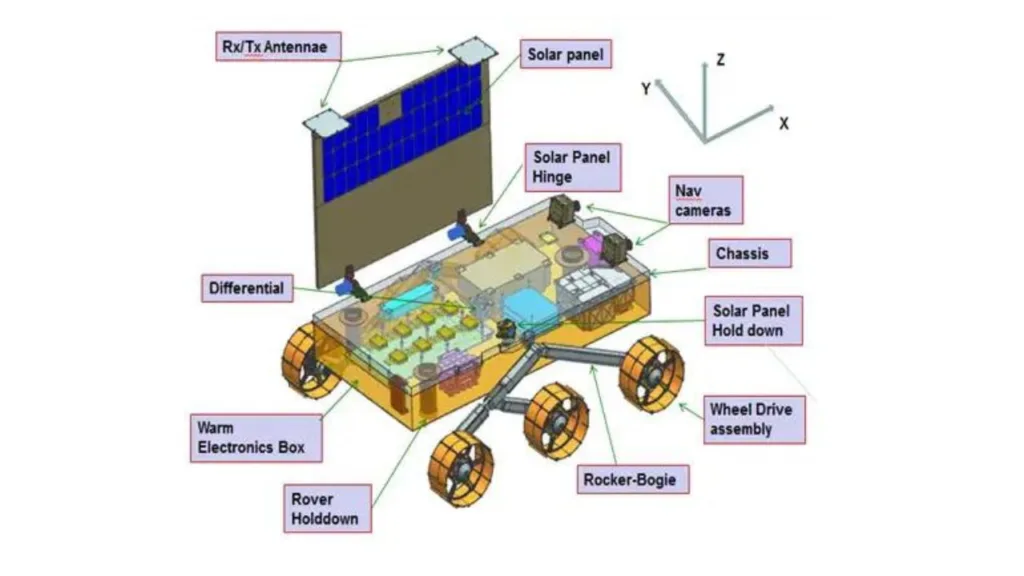Chandrayaan-3 follows the Chandrayaan-2 mission and aims to demonstrate safe landing and mobility on the lunar surface. This mission consists of a Lander and a Rover, and was launched by the LVM3 rocket from SDSC SHAR in Sriharikota on 14 July 2023. The propulsion module will carry the Lander and Rover to a lunar orbit of 100 km. Notably, the propulsion module is equipped with the SHAPE payload for studying Earth from the moon’s orbit.
Lander Payloads:

The Lander carries scientific tools such as ChaSTE, which measures temperature and thermal conductivity, ILSA for seismic activity measurement, and LP to study plasma density. Additionally, a NASA laser reflector aids in lunar laser ranging.
Rover Payloads:

The Rover is equipped with tools like APXS and LIBS to analyze the moon’s elemental composition. Chandrayaan-3 includes an indigenous Lander module (LM), Propulsion module (PM), and Rover with the objective of advancing interplanetary mission technologies. The Lander will softly land on the moon and deploy the Rover for on-site chemical analysis and mobility.
Propulsion Module and Launcher:

The Propulsion Module (PM) is responsible for carrying the LM to the moon’s orbit and separating it. The Chandrayaan-3 mission uses the LVM3 M4 launcher to place the integrated module into an elliptic parking orbit.
Mission Objectives:

The Chandrayaan-3 mission aims to:
- Demonstrate a safe and soft lunar landing.
- Showcase Rover mobility on the moon’s surface.
- Conduct on-site scientific experiments.
Advanced Lander Technologies:
The Lander features advanced technologies, including:
- Altimeters: Laser and RF-based tools for altitude measurement.
- Velocimeters: Laser Doppler Velocimeter and Velocity Camera.
- Inertial Measurement: Laser Gyro-based inertial referencing and Accelerometer.
- Propulsion System: Throttleable Liquid Engines for propulsion.
- Navigation, Guidance, and Control (NGC): Software for powered descent trajectory design.
- Hazard Detection and Avoidance: Cameras and algorithms to detect hazards.
- Landing Leg Mechanism.
Testing the Advanced Technologies:
Several tests were conducted to ensure these advanced technologies work properly:
- Integrated Cold Test: Used a helicopter to test integrated sensors and navigation performance.
- Integrated Hot Test: Used a tower crane to test closed-loop performance with sensors and NGC.
- Lander Leg Mechanism Test: Simulated different touchdown conditions using a lunar simulant test bed.
So, Chandrayaan-3 is a mission to show how we can land on the moon safely, move around, and do science experiments. It has a Lander and a Rover, and they both have special tools and tests to make sure everything works right.
The overall specifications for Chandrayaan-3 are provided below:
| Sl No. | Parameter | Specifications |
|---|---|---|
| 1. | Mission Life (Lander & Rover) | One lunar day (~14 Earth days) |
| 2. | Landing Site (Prime) | 4 km x 2.4 km 69.367621 S, 32.348126 E |
| 3. | Science Payloads | Lander:
|
| 4. | Two Module Configuration |
|
| 5. | Mass |
|
| 6. | Power generation |
|
| 7. | Communication |
|
| 8. | Lander Sensors |
|
| 9. | Lander Actuators | Reaction wheels – 4 nos (10 Nms & 0.1 Nm) |
| 10. | Lander Propulsion System | Bi-Propellant Propulsion System (MMH + MON3), 4 nos. of 800 N Throttleable engines & 8 nos. of 58 N; Throttleable Engine Control Electronics |
| 11. | Lander Mechanisms |
|
| 12. | Lander Touchdown specifications |
|
The objectives of scientific payloads planned on the Chandrayaan-3 Lander Module and Rover are:
| Sl. No | Lander Payloads | ||
|---|---|---|---|
| 1. | Radio Anatomy of Moon Bound Hypersensitive Ionosphere and Atmosphere (RAMBHA) | Langmuir probe (LP) | To measure the near-surface plasma (ions and electrons) density and its changes with time |
| 2. | Chandra’s Surface Thermophysical Experiment (ChaSTE) | To carry out the measurements of thermal properties of the lunar surface near the polar region. | |
| 3. | Instrument for Lunar Seismic Activity (ILSA) | To measure seismicity around the landing site and delineate the structure of the lunar crust and mantle. | |
| 4. | LASER Retroreflector Array (LRA) | It is a passive experiment to understand the dynamics of the Moon system. | |
| 1. | LASER Induced Breakdown Spectroscope (LIBS) | Qualitative and quantitative elemental analysis & To derive the chemical Composition and infer mineralogical composition to further our understanding of the Lunar surface. |
| 2. | Alpha Particle X-ray Spectrometer (APXS) | To determine the elemental composition (Mg, Al, Si, K, Ca, Ti, Fe) of Lunar soil and rocks around the lunar landing site. |
Three-dimensional views of Chandrayaan-3 modules are as shown below:
Chandrayaan-3 – Elements
Chandrayaan-3 – Integrated Module

Chandrayaan-3 Integrated Module – Views

Chandrayaan-3 Lander Module -Views

Chandrayaan-3 Rover on Ramp and Deployed Views

Chandrayaan-3 Propulsion Module – Views

Chandrayaan-3 Rover -Views

Chandrayaan-3 Lander

Chandrayaan-3 Propulsion Module

Chandrayaan-3 Lander

Chandrayaan-3 Rover

Chandrayaan-3 – Mission Profile

